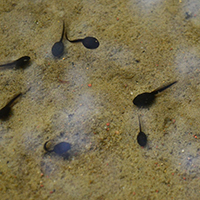Diet of tadpoles for five anuran species of northeast Brazil
Diet of tadpoles to five anuran species

Submitted: 21 April 2019
Accepted: 28 February 2020
Published: 9 March 2020
Accepted: 28 February 2020
Abstract Views: 1320
PDF: 556
HTML: 71
HTML: 71
Publisher's note
All claims expressed in this article are solely those of the authors and do not necessarily represent those of their affiliated organizations, or those of the publisher, the editors and the reviewers. Any product that may be evaluated in this article or claim that may be made by its manufacturer is not guaranteed or endorsed by the publisher.
All claims expressed in this article are solely those of the authors and do not necessarily represent those of their affiliated organizations, or those of the publisher, the editors and the reviewers. Any product that may be evaluated in this article or claim that may be made by its manufacturer is not guaranteed or endorsed by the publisher.
Similar Articles
- Pranay Sharma, Alexey A. Kotov, Establishment of Chydorus sphaericus (O.F. Muller, 1785) (Crustacea: Cladocera) in Australia: consequences of mass fish stocking from Northern Europe? , Journal of Limnology: Vol. 74 No. 2 (2015)
- Andrew Liorti, Teresa Crease, Andreas Heyland, Interactive effects of copper and calcium in Daphnia pulex , Journal of Limnology: Vol. 76 No. 2 (2017)
- Ivana VANÍČKOVÁ, Jaromir SED'A, Jiří MACHÁČEK, Adam PETRUSEK, Effects of extreme floods on the Daphnia ephippial egg bank in a long narrow reservoir , Journal of Limnology: Vol. 70 No. 2 (2011)
- Oscar RAVERA, Gian Maria BEONE, Pier Renato TRINCHERINI, Nicoletta RICCARDI, Seasonal variations in metal content of two Unio pictorum mancus (Mollusca, Unionidae) populations from two lakes of different trophic state , Journal of Limnology: Vol. 66 No. 1 (2007)
- Rossano Bolpagni, Eugenia Bettoni, Francesco Bonomi, Mariano Bresciani, Ketty Caraffini, Silvia Costaraoss, Federica Giacomazzi, Catia Monauni, Paola Montanari, Maria Cristina Mosconi, Alessandro Oggioni, Giovanna Pellegrini, Chiara Zampieri, Charophytes of the lake Garda (Northern Italy): a preliminary assessment of diversity and distribution , Journal of Limnology: Vol. 72 No. 2 (2013)
- Cleber C. Figueredo, Ricardo M. Pinto-Coelho, Ana Maria M.B. Lopes, Pedro H.O. Lima, Björn Gücker, Alessandra Giani, From intermittent to persistent cyanobacterial blooms: identifying the main drivers in an urban tropical reservoir , Journal of Limnology: Vol. 75 No. 3 (2016)
- Marta Bolgan, Emilia Chorazyczewska, Ian J. Winfield, Antonio Codarin, Joanne O'Brien, Martin Gammell, First observations of anthropogenic underwater noise in a large multi-use lake , Journal of Limnology: Vol. 75 No. 3 (2016)
- Sanna T. Korkonen, Antti E.K. Ojala, Emilia Kosonen, Jan Weckström, Seasonality of chrysophyte cyst and diatom assemblages in varved Lake Nautajärvi – implications for palaeolimnological studies , Journal of Limnology: Vol. 76 No. 2 (2017)
- Wen Liu, Long Ma, Jinglu Wu, Jilili Abuduwaili, Environmental variability and human activity over the past 140 years documented by sediments of Ebinur Lake in arid central Asia , Journal of Limnology: Vol. 76 No. 3 (2017)
You may also start an advanced similarity search for this article.

 https://doi.org/10.4081/jlimnol.2020.1912
https://doi.org/10.4081/jlimnol.2020.1912





